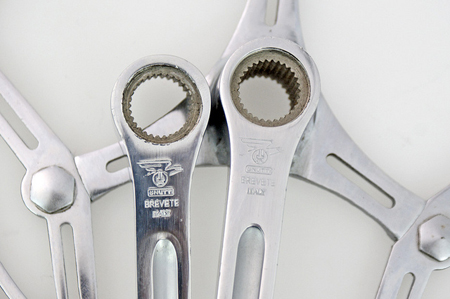Fine Italian Steel
 Wed, February 2, 2011
Wed, February 2, 2011 
On hearing the term “Fine Italian Steel,” what usually springs to mind are handcrafted steel frames, but in the early 1950s, Italy having made a quick recovery from the devastation of WWII, were producing some quite beautiful steel bicycle components.
There were no Campagnolo Groupos in the early 1950s, Campagnolo made quick release hubs and derailleur gears, and that was it. Pedals and cranksets were introduced in the late 50s.
The two main brands I remember were Gnutti and Magistroni, between them they made cranksets, bottom bracket bearings, hubs and headsets.

Gnutti made a really elegant cotterless crankset, (Pictured above.) that fitted onto a tapered and splined BB spindle, and was held in place with recessed Alen screws.
 They also made a less expensive cottered crank, which was the one I used, pictured left.
They also made a less expensive cottered crank, which was the one I used, pictured left.
Both Gnutti and Magistroni cranks were a three arm pattern with the same standard bolt circle diameter.
They were often used in conjunction with the French made Simplex chainrings.
Simplex had these three simple bolt-on adapter arms. (Picture below.)

Gnutti’s quick release hubs were a copy of Tulio Campagnolo’s original idea, I’m not sure if the patent had run out, or they were made under license. The hubs had a chromed steel barrel with aluminum flanges pressed and swaged into place. (Pictures below.)

Finally this Magistroni headset (Pictured below right.) intrigues me; it is quite an engineering masterpiece. How did they get the “Magistroni” name around its circumference?
 It would not have been cast; a casting would not work as a bearing surface.
It would not have been cast; a casting would not work as a bearing surface.
Stamping not possible around the complete circle. It would not have been engraved or pantographed, too costly.
Knowing a little about engineering practices of that era, I believe the lettering was rolled on.
Probably done while the bar stock was in a solid piece, before the headset cup was shaped in a lathe. The bar would be turned slowly and a rotating die with the lettering in reverse pressed into it under great pressure. If anyone else has any alternative theories let me know.
Also note the teeth machined into the top of the bearing cup, with a lock ring with matching teeth. After loosening the top nut, this would allow adjustment by hand, one notch at a time. The lock ring being keyed to the steering tube would prevent the bearing cup from turning as the top nut was re-tightened.






















Reader Comments (10)
Nice!
Cranks are handsome, and the headset ... a little wonder all its own.
Not much difference in size between the inner and outer Simplex rings eh?
John,
The norm back in the 1950s was just 3 teeth difference on the front. Usually 47/50 or 48/51. The rear freewheel was 5 speed, usually in two tooth steps. (14, 16, 18, 20, 22 was typical.) 3 teeth on the front is the same as one tooth on the back, so this provided the in between gears.
Dave
Very cool...
Beautiful! Any idea how the weight compares to today's aluminium and carbon parts.
Gary,
An average race bike in the 1950s weighed around 23 to 25 lbs.
Dave
47/50, 48/51. geez hardly seems worth the extra weight of the double for marginally lower/higher gears.
48x22 versus 51x22, 48x13 versus 51x13.
I assume it was beacuse technology hadn't yet invented gears that could take up more slack?
Thanks Dave
Hi Dave,
Regarding the headset; from an engineering view I agree that rolling would be the most likely way of applying the lettering.
At that time rolling was a very established and common process, it would have been by far the cheapest way to apply the lettering.
It is only with modern CADCAM 'just in time' manufacturing that any other way would be considered. We seem to have lost that middleweight engineering :(
Kevin
Caterham, Surrey
John-
The 47/50 or 48/51 wasn't to get marginally higher or lower gears. It was to get closer-spaced gear ratios. For example, 50x22 comes between 47x22 and 47x20. It's known as "half-step gearing" and is still a reasonable way to set things up if you ride on relatively flat terrain. (I have 42/46 up front, myself. The four-tooth difference works because my cogset has a substantially wider range than 14-22.) On more varied terrain, some people set up the middle and large chainrings of a triple that way (known as "half-step plus granny").
-Eric
I had anew Cinelli track bike in about 1958 ,finished in gold with chrome lugs and
fork ends ,Made to my specs ,she had Gnutti head and bottom bracket sets .
Made Campag pieces look grotty .We had some really great bikes in Salisbury,
Rhodesia in those years .I still cannot get excited about the new frames .